|
Home
Up
| | ~
Parasites, Amateur Dentists, and Snake Charmers ~
April 25 through May 9, 2000
$1 U.S. = 10 dirhams
(Remember
to click on the thumbnails for enlargements of the photos)
Southern Morocco
April 24 through May 3
 (ccl) I don't know of any other country that's smaller than California
that rivals Morocco for sheer diversity of landscape. Riding through
southern Morocco, we saw it all. Parched riverbeds. Red
cliffs. Verdant green oases. Rich farmland. Snow-capped
mountains. Add to this the crumbling ruins of many former settlements and
kasbahs, and you have a fascinating and breathtakingly beautiful
journey.
(ccl) I don't know of any other country that's smaller than California
that rivals Morocco for sheer diversity of landscape. Riding through
southern Morocco, we saw it all. Parched riverbeds. Red
cliffs. Verdant green oases. Rich farmland. Snow-capped
mountains. Add to this the crumbling ruins of many former settlements and
kasbahs, and you have a fascinating and breathtakingly beautiful
journey.
After breakfast and a shower
(promised to be hot; actually cold, but who needs hot water in the Sahara?) we
set off for our next destination, the Todra Gorge. There were some German
tourists who had spent the night at the inn who asked us if we were hiring a
guide to take us back to Erfoud from the desert, and when we said no, they asked
if we had a GPS. We definitely did not see the need for a guide, as all
roads eventually end up at the same place. But they wanted a guide and
didn't have room in their car, so we agreed to take Hammid and Adeal in our car,
back to Erfoud.
After cashing some traveler's checks
at the local bank in a process similar in complexity to applying for dual
citizenship, we were on our way. Our destination: the Todra Gorge.
After about three hours of driving we got there, only to find out that both
hotels were full. No problem: one place would make us a bed in the
upstairs dining room. Since we had slept outside the night before, we were
cool with that. We headed out and did a little hiking in the gorge, which
is quite beautiful, especially at sunset. 
The next day we were up early,
awakened by a huge group of Italian cyclists who were up getting ready for their
ride. We ate our breakfast, which was included in our 50 dirham per head
lodging price. Every time we eat an "included" breakfast at a
hotel, we wonder: who decided that a roll, coffee and juice is breakfast?
Is this a European thing? Because it's kind of absurd, when you think about
it. Where's the protein?? Probably hotels invented it, so that they
could make it look like they were adding value by throwing in breakfast, when in
reality it costs them about 10 cents to serve.
 The drive continued to get more beautiful as we got further away from
the desert. The Dades Gorge is close to the Todra, and while our
book talked up the Todra Gorge as being more spectacular, we actually
liked the Dades Gorge better. It doesn't have the sheer rock walls
and narrow canyon, but the floor is quite beautiful and lush and the buildings
are a deep red color, which comes from the mud used to build them.
We stopped to buy some souvenirs from a nice couple, and she insisted
on dressing me for a photo opportunity. It doesn't show up in the
picture, but this woman was a true Berber, one of the many indigenous
tribes of nomads who have wandered the Sahara for many hundreds of years.
She has the distinctive tattoo on her chin that the people of the different
Berber tribes put on women to indicate which family they are from.
I don't believe the practice is as widespread as it once was. Now
you pretty much only see older women with the tattoos.
The drive continued to get more beautiful as we got further away from
the desert. The Dades Gorge is close to the Todra, and while our
book talked up the Todra Gorge as being more spectacular, we actually
liked the Dades Gorge better. It doesn't have the sheer rock walls
and narrow canyon, but the floor is quite beautiful and lush and the buildings
are a deep red color, which comes from the mud used to build them.
We stopped to buy some souvenirs from a nice couple, and she insisted
on dressing me for a photo opportunity. It doesn't show up in the
picture, but this woman was a true Berber, one of the many indigenous
tribes of nomads who have wandered the Sahara for many hundreds of years.
She has the distinctive tattoo on her chin that the people of the different
Berber tribes put on women to indicate which family they are from.
I don't believe the practice is as widespread as it once was. Now
you pretty much only see older women with the tattoos.
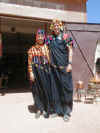
There is a tree that grows only in
southern Morocco and parts of Mexico called the argan tree. This
multi-talented tree has many uses. The wood is extra hard, so it makes
good charcoal. The fruit is good for cattle fodder, and can be fermented
into an alcoholic drink. The oil from the kernels is used in cooking, in
the preparation of sweets, and when combined with almond paste and honey it
makes an incredibly delicious "butter", of which we bought a jar (we
have both been craving peanut butter, which only seems to be available in the
U.S.). The most amazing use of this tree, however, is made by the local goat
population. Apparently, when the trees bloom in the spring, goats love the
tender leaves that come out. I don't know how they figured it out, but
somehow they learned how to climb the argan trees to get at these leaves.
We slammed on brakes and squealed to a halt when we came upon our first sighting
of a tree full of goats. It was a bizarre spectacle. 
We had read in our guidebooks about a
little town called Immouzer des Ida Outanane, which was supposed to be
especially picturesque, and which is famous for spectacular waterfalls in the
spring and a honey festival in the summer. That was our next destination,
but we couldn't drive it all in one day, so we spent the night in a small,
bustling town called Taroudant. The hotel we had picked out of the book
was full, as were two others we checked. This always incites near panic in
me, as I reconsider our night spent on the street in Madrid,
and am hesitant to relive it in Morocco. The third place we checked had
rooms, which cost 30 dirhams per person, no bathroom. I figured this would
work, since we had reservations the next night at a little hotel in Immouzer
that both of our guidebooks had raved about, and hey, you can deal with anything
for one night, right?
We went to bed early that night, as
Wiley was not feeling great. We had both been feeling less than great for
a couple of days, but figured it was just the strange food. We were
awakened around 2:00 by shouting outside our door. It seems that some of
our fellow guests had found the local source of hootch, and one had gotten
remarkably drunk and argumentative with his pals. Moroccans are
argumentative to begin with. All over this country we have watched as
people, usually men, yell and scream at each other, then go about their
business. I guess it's the culture. One of the guys who worked for
Wiley in the insurance business was Syrian, and during one of their frequent
arguments he explained that arguing is part of the Middle Eastern culture. But
when this argument kept up for more than a minute, I stuck my head out the door
in order to glare them into silence. That didn't work. It kept up,
and it sounded like somebody was going to get hurt. The next time we
looked out the door, the police were there. I was reminded of one of my
father's favorite sayings, "You get what you pay for," and in the case
of a $6 hotel room, we certainly had.
 The drive to Immouzer was spectacular, as the guidebooks had promised. It
wound up through a beautiful canyon, and the floor below was covered with farms
and palm trees. The hotel was also as promised, although the weather had
gotten cloudy and we couldn't enjoy the pool. We hiked to the site of the
waterfalls, but due to the drought, there were none. It was still a
beautiful area, and nice to stay in a really good hotel after the two slightly
dicey nights previous.
The drive to Immouzer was spectacular, as the guidebooks had promised. It
wound up through a beautiful canyon, and the floor below was covered with farms
and palm trees. The hotel was also as promised, although the weather had
gotten cloudy and we couldn't enjoy the pool. We hiked to the site of the
waterfalls, but due to the drought, there were none. It was still a
beautiful area, and nice to stay in a really good hotel after the two slightly
dicey nights previous.
 The next morning we left for the final leg of our trip through Morocco by car, a
little fishing village on the Atlantic called Essaouira. At this point I
was feeling really awful, as Wiley had two days prior. We got to Essaouira
and I crashed. It was a beautiful, quaint place, that was alive with
tourists and locals alike, but I could have cared less. By the next day,
Wiley was sick again. This sent me to our Travel Medicine Guide for
a consultation. Obviously, we were no longer dealing with a simple case of
traveler's stomach, as this had been going on for several days now. Some
people will tell you not to buy the pre-made first aid kits that are sold at
traveler's specialty stores like REI and The Civilized Traveler. They say
you can easily make up your own with stuff you can buy at the drugstore. This might be true, but I was
particularly glad that we had one we had bought at REI, because it contained a
little book that reviewed the symptoms and cures of many common travel-related
illnesses. It was here that I discovered, through a somewhat obscure
symptom description that I won't burden you with, that we both had contracted
the water-born parasite, giardia. The book told exactly what to take and
how much, so I headed off for the pharmacy. We were both feeling much
better in 48 hours. I can't imagine how we got it, since we are very
careful about drinking water, and never use the water from the tap in any hotel,
regardless of how nice the place is.
The next morning we left for the final leg of our trip through Morocco by car, a
little fishing village on the Atlantic called Essaouira. At this point I
was feeling really awful, as Wiley had two days prior. We got to Essaouira
and I crashed. It was a beautiful, quaint place, that was alive with
tourists and locals alike, but I could have cared less. By the next day,
Wiley was sick again. This sent me to our Travel Medicine Guide for
a consultation. Obviously, we were no longer dealing with a simple case of
traveler's stomach, as this had been going on for several days now. Some
people will tell you not to buy the pre-made first aid kits that are sold at
traveler's specialty stores like REI and The Civilized Traveler. They say
you can easily make up your own with stuff you can buy at the drugstore. This might be true, but I was
particularly glad that we had one we had bought at REI, because it contained a
little book that reviewed the symptoms and cures of many common travel-related
illnesses. It was here that I discovered, through a somewhat obscure
symptom description that I won't burden you with, that we both had contracted
the water-born parasite, giardia. The book told exactly what to take and
how much, so I headed off for the pharmacy. We were both feeling much
better in 48 hours. I can't imagine how we got it, since we are very
careful about drinking water, and never use the water from the tap in any hotel,
regardless of how nice the place is.
Somehow we managed to pass a week in
Essaouira. After we spent the first couple of days recovering, we just
kept saying, "How about one more night here?". We spent the days
sunning ourselves on the terrace of our hotel, and the nights wandering through
the narrow streets, shopping and eating great food. Travel is hard work -
don't let anyone kid you about that. One of the unique things about
Essaouira is a fresh fish market right by the waterfront where you can pick out
your fish and get it grilled while you wait. Served with fresh bread and a
tomato and onion salad, it makes a delicious meal, and you can't beat the
view. 
Marrakech, Morocco
May 3 through May 7
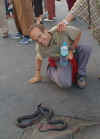 (ccl) I guess my first clue that Marrakech was going to be unlike anything
we had ever seen before came when our bus from Essaouira stopped and picked up a
gum-chewing monkey as a passenger. There is a huge paved square in the
middle of the Marrakech medina, and all roads lead there, literally and
figuratively.
(ccl) I guess my first clue that Marrakech was going to be unlike anything
we had ever seen before came when our bus from Essaouira stopped and picked up a
gum-chewing monkey as a passenger. There is a huge paved square in the
middle of the Marrakech medina, and all roads lead there, literally and
figuratively.
Djemaa el Fna, as that square is
called, is the main attraction
in Marrakech, and what goes on there probably fits most people's image of
Morocco. The plaza is the main gathering point for locals and tourists
alike, and we found ourselves drawn to it repeatedly. Different things go
on there during different times of the day. Sometimes there are veiled
women using syringes to pipe henna designs onto the hands and feet of waiting
tourists, other times there are snake charmers blowing exotic tunes from flutes,
apparently mesmerizing nearby cobras. There are all types of herbal
medicine practitioners, and there are a couple of guys there who will
(supposedly) pull a nagging tooth for you. There's usually someone
testifying about the power of some particular product, and there are clumps of
people listening as two or more of them argue a topic,
"Point/Counterpoint"-style. At night, the fire eaters,
storytellers, and musicians come out. There are food vendors selling
everything from fresh steamed escargot to goat's brains to couscous to
lamb kebobs. It's all cooked fresh, right there, and everything we ate was
quite delicious (sorry, can't give you a report on those goat's brains).
The perimeter of the whole circus is lined with carts from which men hawk
fresh-squeezed orange juice, and they compete furiously for your business.
Moroccan citrus fruit is absolutely fabulous, much better than anything I've
ever had from Florida. Minute Maid will never gain a foothold here, when a
glass of the fresh-squeezed stuff can be had for 25 cents.
 The air is electric in and around Djemaa el Fna. Around 6:00 PM, things
really get going, and people pack the surrounding streets, strolling arm-in-arm,
enjoying the weather and the atmosphere. One aspect of Djemaa el Fna that
is especially nice is that the place, while certainly in large part catering to
tourists, is also frequented by Moroccans. It's unusual to see Moroccans
elsewhere in the country eating out, so we enjoyed sharing meals with many
friendly people. The pressure's off here, because everyone's just out to
enjoy some entertainment or food. No one's trying to hustle the tourists,
because the brigade touristique is out in full force, and there are
stiff fines to be paid for hassling. Many people asked us where we were
from in halting English, and most wanted no more than to say,
"Welcome to Morocco".
The air is electric in and around Djemaa el Fna. Around 6:00 PM, things
really get going, and people pack the surrounding streets, strolling arm-in-arm,
enjoying the weather and the atmosphere. One aspect of Djemaa el Fna that
is especially nice is that the place, while certainly in large part catering to
tourists, is also frequented by Moroccans. It's unusual to see Moroccans
elsewhere in the country eating out, so we enjoyed sharing meals with many
friendly people. The pressure's off here, because everyone's just out to
enjoy some entertainment or food. No one's trying to hustle the tourists,
because the brigade touristique is out in full force, and there are
stiff fines to be paid for hassling. Many people asked us where we were
from in halting English, and most wanted no more than to say,
"Welcome to Morocco".
 Wiley and I compared the scene at Djemaa el Fna repeatedly to the New Orleans
Jazz and Heritage Festival, an annual ritual that we missed last weekend for the
first time in 10 years (and vowed that we would never miss again, as long as
there is breath in our bodies). There are plenty of strange people doing myriad
things for money, there's music, there's great food to be had a ridiculously
low prices, and the weather is great. The only thing missing from the
scene was the Slidell Lion's Club and their Miller Lite concession.
Alcohol is a little hard to get here in Morocco, but not impossible, as it is in
other Muslim countries. Most of the medium to large hotels have bars, and
many restaurants are licensed, but it's expensive, relatively speaking.
Often two beers (or even just one) will set you back more than the food itself.
Wiley and I compared the scene at Djemaa el Fna repeatedly to the New Orleans
Jazz and Heritage Festival, an annual ritual that we missed last weekend for the
first time in 10 years (and vowed that we would never miss again, as long as
there is breath in our bodies). There are plenty of strange people doing myriad
things for money, there's music, there's great food to be had a ridiculously
low prices, and the weather is great. The only thing missing from the
scene was the Slidell Lion's Club and their Miller Lite concession.
Alcohol is a little hard to get here in Morocco, but not impossible, as it is in
other Muslim countries. Most of the medium to large hotels have bars, and
many restaurants are licensed, but it's expensive, relatively speaking.
Often two beers (or even just one) will set you back more than the food itself.
We visited all the interesting sites
in Marrakech. The 16th century Saadian Tombs were discovered only in 1917,
having been sealed off by the villainous Moulay Ismail, a17th century Allaouite
sultan who often had slaves killed simply because he didn't like the color of
their clothing on a particular day. And you thought women were
moody. The tombs were used as a burial chamber for the Sultans and their
families of the Saadian dynasty. The plaster and cedar carvings are quite
ornate, as are the plots themselves, which are covered in zellig tilework.
Islam strictly prohibits the use of any type of iconography, hence the use of
ornate tilework as decoration. 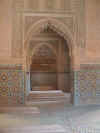
Another fascinating site in Marrakech
is the El Badi Palace, also dating to the 16th century. The
"palace" itself isn't much more than a massive area surrounded by red
earth (characteristic of Marrakech) walls, because all of the gold, onyx, and
marble was looted and carried away by that perennial bad guy, Moulay Ismail, to
decorate his favorite city and the capital of his empire, Meknes. The
highlight of this visit wasn't the palace itself, but an exhibit inside the
palace that contains the recently restored 12th centuryminbar from
the Koutoubia Mosque. The minbar might be compared to the pulpit in a
Christian church. The imam, the spiritual leader of the mosque, climbs the
minbar, which looks like an unattached stairway, to deliver the sermon at Friday
noon prayers. It was amazing that this piece had been in constant use for
almost 800 years before it was restored, with the help of the Metropolitan
Museum of Art in New York and placed on permanent display in the palace.
Sorry, no photos allowed, or we'd show you a picture. It was amazingly
intricate, with teeny-tiny pieces of carved inlaid wood and bone.
We finished off our last day in
Marrakech by running errands and working on the computer. We've had a lot
of trouble accessing our bank account from Morocco, only being able to get into
it twice. We think it may have something to do with the Internet
congestion within Morocco - someone told us that there are only four Internet
points-of-presence in all of Morocco! Since we can't dial in with our
computer, we're left to buy time at Internet cafes, which is slightly more
expensive here and usually slow. We did find a place with decent speed in
Marrakech, got our banking done, then headed to the train station, where we
bought tickets for Casablanca, and I sit on that train as I write this, gliding
over the arid Moroccan countryside, glimpsing a crumbling kasbah or two every
now and then. In two days we fly to Cairo, where we start a new adventure
in the valley of the Nile.
Casablanca, Morocco
May 7 through May 9
(ccl) Casablanca is a new city
on the Moroccan landscape, having been around only a couple of hundred
years. The medina isn't much to speak of, but it's the biggest, most
modern city in Morocco. The train ride there was very pleasant.
Whatever unconscionable things the French did to the Moroccans during the time
of their "protectorate", they sure built a damn fine railroad.
We made the trip in three hours, checked into a nice hotel, and got a balcony
looking down on the street.
There's some interesting architecture
in Casablanca, most of it 19th and 20th century, and it's a pleasant place to
walk around. There are bars in Casablanca, which you don't see much of in
other Moroccan towns, and it shows. You'll be casually walking down the
street, and you'll pass a doorway, and all of a sudden you'll be greeting by a cacophony
of drunken, slurring voices, shouting, "Welcome to Morocco!", and
"How are you? I am fine!". Certainly a sign of
friendliness but disconcerting, nonetheless. Not the kind of place you'd
go into for a drink.
We needed traveler's checks.
You may have read Wiley's account of our Travel
Challenges, and if you have you know that we discovered after leaving the
country that our American Express ATM card doesn't work outside the U.S.
"Don't leave home without it!" Anyways, we've been using
our VISA card in the ATM's for cash advances, which we then pay back through our
online checking account, but we also like to have traveler's checks. We
spent one morning in Casablanca going to the American Express office to get
$2000 in checks (AMEX will only let you have $1000 per month, per card).
We had finally arrived at the end of a lengthy process which involved carbon
paper (you know when they pull out the carbon paper that you are in for some bureaucracy)
when she handed our paperwork to us and gave us directions on how to get to the
bank to get our checks. For some reason, the AMEX office doesn't keep the
checks, they just fill out the paperwork. So we trekked to the bank, where
they spoke enough English to ask us to come back at 2:05 and get the
checks. It seemed that they didn't have the key to the box where the
checks were kept right then, but they would get it by 2:05. Here's the
lesson: when you're in the third world, always expect things to take at
least twice as long as they would have at home.
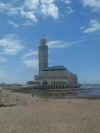 The main attraction in Casablanca is the seven year-old Hassan II mosque.
According to our guidebook, it was the "gift of a thankful country to their
beloved monarch", on the occasion of his 75th birthday. Every
household in Morocco "donated" money to build the elaborately
beautiful structure, which is the largest religious structure in the world,
bigger than even St. Peter's Basilica in Rome. As non-Muslims, we are
typically not allowed in the mosques in Morocco, but Hassan II was open to
tourists five times a day. At 100 dirhams per person, the tour was more
expensive by ten times any other monument we had seen at that point in
Morocco.
The main attraction in Casablanca is the seven year-old Hassan II mosque.
According to our guidebook, it was the "gift of a thankful country to their
beloved monarch", on the occasion of his 75th birthday. Every
household in Morocco "donated" money to build the elaborately
beautiful structure, which is the largest religious structure in the world,
bigger than even St. Peter's Basilica in Rome. As non-Muslims, we are
typically not allowed in the mosques in Morocco, but Hassan II was open to
tourists five times a day. At 100 dirhams per person, the tour was more
expensive by ten times any other monument we had seen at that point in
Morocco.
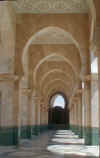 But there was no question but that we were going, as we had been in Morocco for
a month, passing by mosque after mosque, peering in at people, but not being
admitted. Let's just say that your curiosity gets the better of you.
Hassan II has space in the main prayer hall for 20,000 male worshippers and 5000
female worshippers in the balcony (let's not forget that Muslim prayer services
are segregated by gender), plus room outside on the huge marble-paved area for
an additional 40,000 worshippers. The place even has two hammams ,
which are bathhouses for cleansing the body (very important in Islam), which
aren't in use. The fact is, a lot of the external buildings aren't in use,
because there is no money to open them. Wiley asked our tour guide how
many people typically attend one of the five daily prayer services, on average,
and she said 100 to 200. It was somewhat sobering, because you got the
feeling that millions and millions of dollars had been donated by people who
didn't have much to live on to begin with, for a monument that is rarely used.
But there was no question but that we were going, as we had been in Morocco for
a month, passing by mosque after mosque, peering in at people, but not being
admitted. Let's just say that your curiosity gets the better of you.
Hassan II has space in the main prayer hall for 20,000 male worshippers and 5000
female worshippers in the balcony (let's not forget that Muslim prayer services
are segregated by gender), plus room outside on the huge marble-paved area for
an additional 40,000 worshippers. The place even has two hammams ,
which are bathhouses for cleansing the body (very important in Islam), which
aren't in use. The fact is, a lot of the external buildings aren't in use,
because there is no money to open them. Wiley asked our tour guide how
many people typically attend one of the five daily prayer services, on average,
and she said 100 to 200. It was somewhat sobering, because you got the
feeling that millions and millions of dollars had been donated by people who
didn't have much to live on to begin with, for a monument that is rarely used.
This was our last day in Morocco, and
we had a good lunch in the area of town known as the Corniche, which has lots of
fancy beachclubs and restaurants. Still a little early in the season, so
none of the clubs were open, but it looked like a fun area. Our flight to
Cairo was at 8:40 P.M., so after lunch we headed back to our hotel to get our
bags. I asked the front desk clerk at our hotel how much a taxi ride to
the airport cost, and he told me 200 dirhams. This seemed like an exorbitant
sum, but as I later learned, the airport is a good 45 minutes away. He
told us we could take a train to the airport for 22 dirhams, but we missed that,
so now we had to cough up the money for a taxi. We didn't have enough
cash, and the cash machines told us that the link to VISA International was down
(great timing), so we jumped in a cab with a guy who said he could take us to
the Hyatt, where they would cash a traveler's check. Got the money,
practically flew to the airport, and made check-in with plenty of time to
spare. Ran onto the plane during final boarding call because we had stayed
in the bar too long. Typical...
We flew Egyptair to Cairo. No
doubt, by the end of this trip, we will have logged significant time with
obscure air carriers, and don't think I wasn't thinking about that Egyptair
flight that went down a few months ago with the pilot and co-pilot apparently
struggling for the controls. I'm happy to report that we arrived safe and
sound in Cairo, with no complaints of Egyptair, and now we begin another chapter
in the Long's Strange Trip.
Click
here to continue in Egypt with "Muslim Extremist or Salesman?"
|
